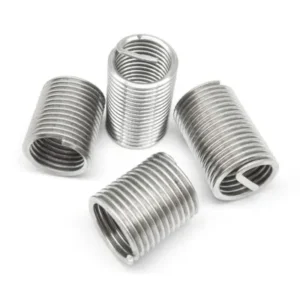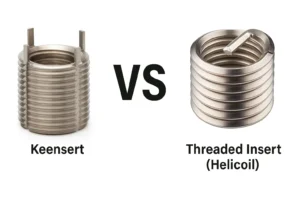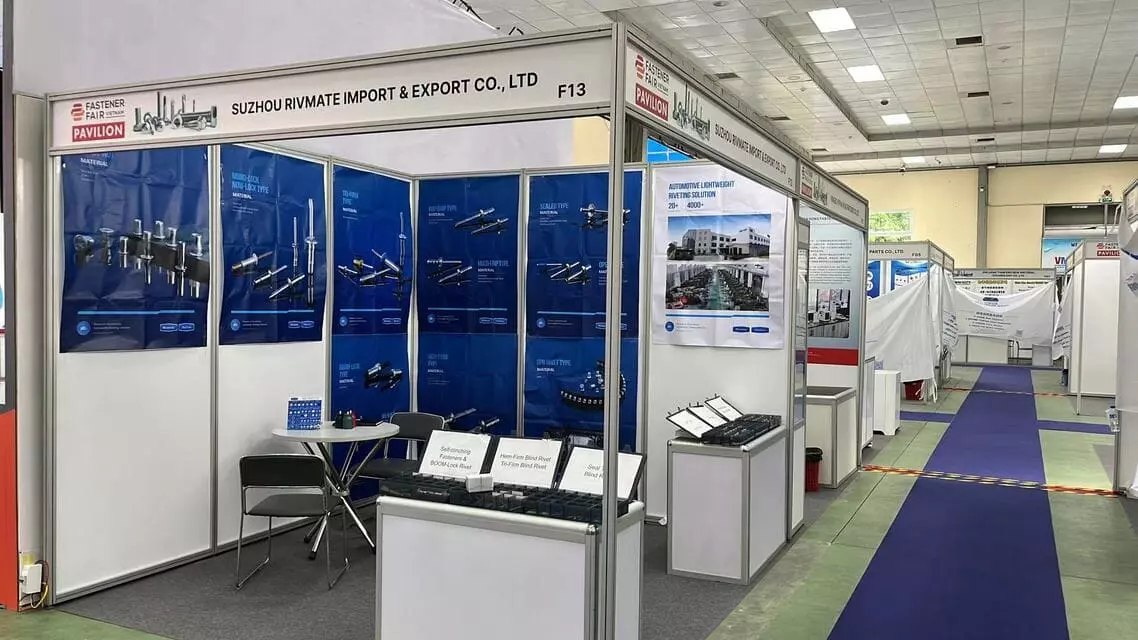Rivet Nut Inserts Stainless Steel 316 vs 304
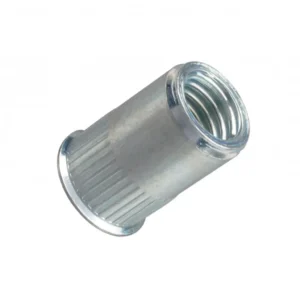
Leading Rivet Nut Manufacturer and Supplier in China
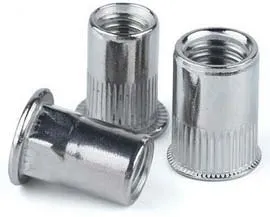
When choosing between rivet nut inserts stainless steel 316 and 304, it’s essential to understand their differences in terms of corrosion resistance, strength, and ideal applications. Whether you’re working in a general or harsh environment, selecting the right rivet nut insert can significantly impact the durability and performance of your project.
Table of Contents
What Are the Benefits of Stainless Steel?
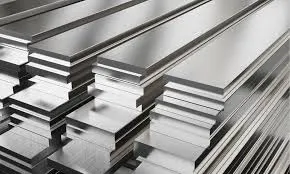
Stainless steel is a widely used alloy material known for its excellent corrosion resistance, strength, and aesthetic appeal. Different types of stainless steel are suitable for various applications, especially in environments that require high durability and low maintenance.
1. Excellent Corrosion Resistance
One of the primary advantages of stainless steel is its outstanding corrosion resistance. Due to its chromium (Cr) content, it forms a dense chromium oxide protective layer on the surface, effectively preventing moisture, oxygen, and acidic or alkaline substances from causing corrosion. Compared to carbon steel or ordinary alloy steel, stainless steel performs better in humid environments, marine climates, and the chemical industry. For example, in shipbuilding, food processing, and chemical storage tanks, stainless steel resists corrosion, ensuring long-term durability.
2. High Strength and Durability
Stainless steel has higher yield strength and tensile strength than ordinary steel, making it resistant to heavy loads and impacts without deformation or breakage. This high strength makes it an ideal material for structural construction, automotive parts, and aerospace applications. For instance, in bridge supports, high-speed train bodies, and aircraft engines, stainless steel enhances structural safety and prolongs service life by withstanding long-term mechanical stress.
3. Excellent High and Low Temperature Resistance
Stainless steel maintains its stability under extreme temperatures. At high temperatures, it resists oxidation and retains its strength, making it widely used in boilers, heat exchangers, and engine exhaust systems. On the other hand, certain stainless steel alloys (such as austenitic stainless steel) retain good toughness and impact resistance even in low temperatures, making them suitable for cryogenic storage tanks and machinery in extreme cold environments. This versatility allows stainless steel to perform well in a wide range of demanding conditions.
4. Aesthetic Appeal, Easy Maintenance, and Low Cost
With a smooth, easy-to-clean surface, stainless steel resists stains, fingerprints, and watermarks better than ordinary metals, making it easier to maintain. Its surface can undergo brushed, mirror, sandblasted, or titanium-plated finishes to meet different aesthetic requirements. In industries such as high-end architecture, home kitchens, and medical equipment, stainless steel is a preferred material due to its rust resistance, anti-staining properties, and easy cleaning. Additionally, its long lifespan and durability help reduce maintenance and replacement costs.
5. Eco-Friendly and Fully Recyclable
Stainless steel is a 100% recyclable material, and the recycling process does not degrade its original properties, making it an environmentally sustainable metal. Unlike other materials, stainless steel does not release harmful substances during production or use, ensuring it does not contaminate food, medical equipment, or drinking water systems. This makes stainless steel an irreplaceable material in industries requiring high safety and hygiene standards, such as food processing, medical devices, and water supply systems.
Summary - The Benefits of Stainless Steel
Stainless steel, with its corrosion resistance, mechanical strength, aesthetic appeal, low maintenance costs, workability, and environmental friendliness, is the material of choice for modern manufacturing, construction, food processing, medical devices, and more. Whether it’s standard 304 stainless steel or more corrosion-resistant 316 stainless steel, it excels in various environments and provides reliable solutions for engineering and industrial applications.
What Are the Stainless Steel Applications?

1. Architecture and Decoration
Stainless steel’s durability, corrosion resistance, and aesthetic appeal make it a popular choice in architecture and decoration:
- Structural Applications: Used in bridges, stair railings, curtain walls, and building frames, providing both strength and modern aesthetics.
- Decorative Elements: With various surface finishes (mirror, brushed, sandblasted), stainless steel is widely used in high-end building facades, doors, windows, ceilings, and stair railings, enhancing architectural beauty.
- Urban Infrastructure: Found in subway stations, stainless steel sculptures, railings, and bus shelters, offering weather resistance and low maintenance costs.
2. Automotive and Transportation
Stainless steel is essential in the automotive, marine, railway, and aerospace industries due to its corrosion resistance, impact resistance, high-temperature tolerance, and lightweight properties:
- Automotive Manufacturing: Used in exhaust systems, fuel tanks, vehicle frames, engine components, and braking systems, enhancing durability and reducing maintenance costs.
- Marine Industry: In marine environments, regular steel is prone to corrosion, whereas stainless steel (especially 316L stainless steel) is resistant to seawater, making it ideal for ship hulls, propulsion systems, pipelines, and fuel tanks.
- Rail and Aerospace: Stainless steel is used in high-speed train compartments, aircraft engines, fuel systems, and structural components, ensuring reduced weight, increased durability, and improved safety.
3. Food Processing and Catering Industry
Stainless steel is widely used in food processing and catering due to its non-toxic properties, antibacterial nature, and easy cleaning, ensuring food safety:
- Food Processing Equipment: Utilized in mixers, ovens, storage tanks, conveyors, ensuring food remains uncontaminated while making cleaning easier.
- Kitchen Utensils: High-quality stainless steel cookware (such as knives, pots, sinks, and cutlery) is durable, rust-resistant, and long-lasting.
- Food Packaging: Stainless steel is used in canning equipment, water dispensers, and storage containers to maintain food freshness and hygiene.
4. Medical and Pharmaceutical Industry
Stainless steel is crucial in the medical field due to its corrosion resistance, antibacterial properties, ease of sterilization, and biocompatibility, meeting stringent hygiene standards:
- Medical Instruments: Surgical knives, forceps, syringes, and implants (such as artificial joints, bone screws, bone plates, and dental implants) are made from high-grade medical stainless steel (e.g., 316L stainless steel) to ensure durability and compatibility with the human body.
- Hospital Equipment: Used in surgical tables, hospital beds, sterile carts, and laboratory workbenches, providing easy disinfection and reducing infection risks.
- Pharmaceutical Industry: Stainless steel is used in drug manufacturing equipment, sterile production lines, storage tanks, and transport pipelines, ensuring contamination-free pharmaceutical production.
5. Energy and Chemical Industry
Stainless steel is widely used in the energy and chemical industries due to its high-temperature resistance, acid and alkali resistance, and oxidation resistance, making it ideal for extreme environments:
- Petrochemical Industry: Used in oil and gas pipelines, refining units, storage tanks, and pressure vessels, protecting against acidic gases and corrosive substances.
- Renewable Energy: Found in solar panel brackets, wind turbine components, and nuclear power equipment, ensuring durability and longevity in harsh environments.
- Seawater Desalination: Stainless steel (especially super duplex stainless steel) is used in desalination systems for evaporators, filters, and pipelines, preventing corrosion in high-salinity conditions.
6. Electronics and Precision Instruments
Stainless steel’s stable conductivity, anti-magnetic properties, and oxidation resistance make it essential in electronics and precision instruments:
- Consumer Electronics: Stainless steel is used in smartphone casings, laptops, and smartwatches, enhancing durability, wear resistance, and corrosion protection.
- Precision Instruments: Found in laboratory equipment, measuring devices, and sensor housings, ensuring long-term stability and accuracy.
- Battery Manufacturing: Stainless steel is used in lithium battery casings and electrode plates, improving battery safety and longevity.
7. Home Appliances and Daily Products
Stainless steel is commonly used in household appliances and daily necessities due to its durability, easy maintenance, and oxidation resistance, improving product quality and lifespan:
- Home Appliances: Used in dishwashers, microwaves, refrigerators, kettles, and coffee machines, ensuring heat resistance, longevity, and easy cleaning.
- Bathroom Products: Stainless steel is widely used in faucets, showers, bathroom cabinets, and sinks, offering rust resistance and a long-lasting shine.
- Sports Equipment: Found in stainless steel fitness equipment, ski poles, and bicycle parts, ensuring strength and durability for various sports applications.
Do You Have Any Questions?
Let Us Solve Your Problem
304 vs. 316 Stainless Steel Rivet Nut Inserts
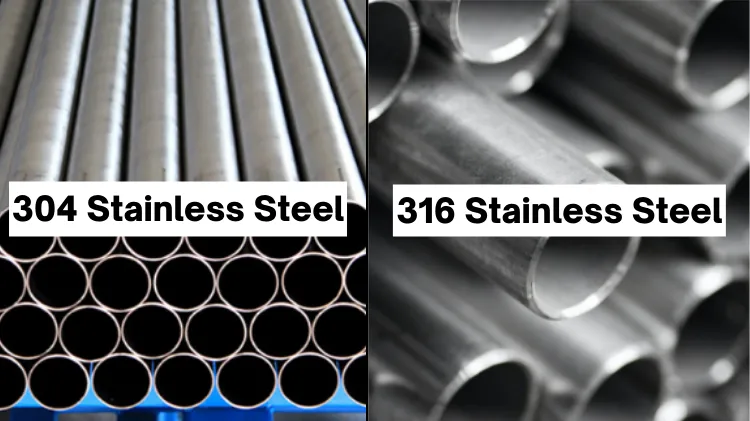
1. Chemical Composition
- 304 Stainless Steel: Composed mainly of 18% chromium (Cr) and 8% nickel (Ni), sometimes referred to as 18-8 stainless steel.
- 316 Stainless Steel: Contains 16-18% chromium (Cr), 10-14% nickel (Ni), and an additional 2-3% molybdenum (Mo), which enhances its corrosion resistance, especially in marine and chemical environments.
2. Corrosion Resistance
- 304 Rivet Nuts: Performs well in general environments, humid air, and freshwater, but may corrode in high salt, acidic, or chemical environments.
- 316 Rivet Nuts: With the addition of molybdenum (Mo), 316 stainless steel offers superior corrosion resistance, particularly suited for marine, chemical, high-humidity, and high-salinity environments, such as coastal areas or chemical plants.
3. Mechanical Properties
- 304 Rivet Nuts: High strength and good toughness, suitable for most mechanical structures and general industrial applications.
- 316 Rivet Nuts: Similar to 304 in terms of strength but offers greater stability in high-temperature and high-pressure environments, with better creep resistance.
4. Suitable Environments
- 304 Rivet Nuts are suitable for:
- General industrial equipment
- Indoor mechanical structures
- Food processing, kitchen equipment
- Common humid environments
- 316 Rivet Nuts are suitable for:
- Marine environments, ships (resistant to salt spray corrosion)
- Chemical plants, acidic/alkaline environments
- High-temperature and high-humidity environments (e.g., boilers, petrochemical equipment)
- Medical devices, biopharmaceuticals (higher hygiene requirements)
5. Cost
- 304 Rivet Nuts: Lower cost, suitable for general applications.
- 316 Rivet Nuts: More expensive due to the addition of molybdenum (Mo), typically used in applications requiring higher corrosion resistance and strength.
6. Machining and Welding Performance
- 304 Rivet Nuts: Easy to machine and weld, widely used for structural components and fasteners.
- 316 Rivet Nuts: Relatively harder to machine due to the presence of molybdenum (Mo), requiring higher specifications for machining and welding.
Table: 304 vs. 316 Stainless Steel Rivet Nut Inserts Comparison
| Comparison Factor | 304 Rivet Nuts | 316 Rivet Nuts |
| Main Composition | 18% Cr, 8% Ni | 16-18% Cr, 10-14% Ni, 2-3% Mo |
| Corrosion Resistance | General corrosion resistance, suitable for freshwater and typical environments | Superior corrosion resistance, suitable for marine and chemical environments |
| Strength | High strength, suitable for most mechanical equipment | Similar strength to 304, but better high-temperature and high-pressure resistance |
| Suitable Environments | Indoor, general industrial equipment, food processing | Marine environments, chemical plants, high-temperature and high-humidity locations |
| Cost | Lower cost | Higher cost |
| Machining Performance | Easy to machine and weld | More difficult to machine, requires specialized equipment |
Summary - The Benefits of 316 Stainless Steel
316 stainless steel rivet nuts, due to the inclusion of 2-3% molybdenum (Mo), offer superior corrosion resistance, high-temperature, and salt spray resistance.
If your application involves highly corrosive environments, marine, chemical, or high-temperature and high-pressure conditions, it is recommended to choose 316 rivet nuts to improve the reliability and longevity of your equipment.
How to Choose Between 304 and 316 Rivet Nut Inserts?
When to Choose 304 Rivet Nuts
Suitable for general industrial and indoor applications, cost-effective and high value for money
General Dry Environments (indoor mechanical equipment, furniture fasteners, etc.)
If the rivet nut will not be exposed to prolonged moisture or corrosive environments, 304 is sufficient.
Food Processing Equipment, Kitchen Utensils
304 stainless steel offers good corrosion resistance and safety, making it ideal for food-grade applications.
Low Corrosion Environments (slightly humid but no salt spray or chemical exposure)
304 can withstand mild moisture but is not suitable for high salt or strong acid/alkali environments.
Cost-Sensitive Projects
304 rivet nuts are 30-50% cheaper than 316, making them a more cost-effective choice if extreme corrosion resistance is not required.
When to Choose 316 Rivet Nuts
Suitable for harsh environments, especially high humidity, high salt, and high chemical corrosion environments
Marine Environments (high salt, humid air, seawater exposure)
316 contains 2-3% molybdenum (Mo), which effectively resists salt spray corrosion, seawater corrosion, and chloride ion erosion.
Chemical and Pharmaceutical Industries (exposure to acids, alkalis, and corrosive chemicals)
316 has higher corrosion resistance, making it suitable for chemical plants, pharmaceutical equipment, and other highly corrosive environments.
Outdoor Exposure Environments (long-term exposure to wind, sun, and rain)
In high humidity and long-term sun and rain exposure, 316 offers better weather resistance to prevent rust and oxidation.
High Temperature and High Pressure Environments (boilers, steam equipment, petrochemical industry)
316 has better high-temperature resistance than 304, making it ideal for high-temperature steam, high-pressure pipelines, boiler systems, and more.
Table: How to Choose 304 vs. 316 Stainless Steel Rivet Nut Inserts
| Selection Criteria | 304 Rivet Nuts | 316 Rivet Nuts |
| Corrosion Resistance | General corrosion resistance, suitable for regular environments | Superior corrosion resistance, suitable for seawater, acidic environments |
| Salt Spray Resistance | Not recommended for prolonged exposure to salt spray | Can be used long-term in marine and coastal environments |
| High-Temperature Resistance | Maximum temperature 870-925°C | Maximum temperature 1090-1150°C |
| Strength and Hardness | Standard strength | Slightly higher than 304 |
| Machinability | Easy to machine and weld | Higher hardness, slightly more difficult to machine |
| Applicable Industries | General machinery, construction, household equipment | Marine, chemical, pharmaceutical, nuclear, petrochemical industries |
| Price | More affordable, high value for money | Higher cost, but lower maintenance costs |
Recommendation:
- If the budget is limited and the environmental requirements are not demanding, choose 304 rivet nuts, which offer great value for money.
- If you need to use the rivet nuts in harsh environments (seawater, chemicals, high temperatures, etc.) for long periods, choose 316 rivet nuts, as they have a longer service life and lower maintenance costs.
Do You Have Any Questions?
Let Us Solve Your Problem
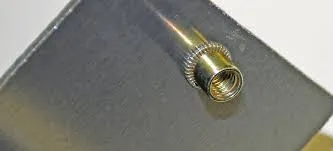
Choose the Right Rivet Nuts
Different types of rivet nuts should be considered for different materials. Including their body types, head types. Read the following blog to find out how to choose different rivet nuts for different materials and applications. Ensure you choose a rivet nut that matches the base material thickness and strength requirements.
- Manual Rivet Nut Gun: Suitable for small sizes (M3-M6), ideal for low-frequency installations.
- Pneumatic Rivet Nut Gun/Electric Rivet Nut Gun: Suitable for mass production, providing stable riveting pressure to reduce errors.
- Hydraulic Riveting Tool: Suitable for large sizes (M8-M12), ideal for high-strength applications such as machinery, bridges, etc.
2. Installation Steps
1: Prepare the Hole
Choose the appropriate drill bit size for rivet nuts to ensure the hole diameter matches the outer diameter of the rivet nut.
Example: M6 rivet nuts typically use a 9mm hole, and M8 uses an 11mm hole.
Clean the hole to remove burrs, ensuring smooth installation of the rivet nut.
2: Attach the Rivet Nut to the Rivet Nut Gun
- Screw the rivet nut onto the bolt of the rivet nut gun, ensuring it is fully aligned.
- Note: Do not screw it in too tightly to avoid damaging the threads.
3: Rivet the Rivet Nut
- Align the rivet nut with the hole, ensuring it is fully inserted into the base material.
- Apply pulling force using the rivet nut gun, causing the rivet nut to expand inside the hole and tighten.
- Note:
- Apply appropriate pressure; excessive pulling may cause the rivet nut to deform or even damage the base material.
- It is recommended to use a rivet nut gun with adjustable torque to avoid overloading.
4: Check the Installation Quality
- Ensure the rivet nut is flush with the base material surface without noticeable deformation or loosening.
- Test the inner threads of the rivet nut by screwing in a bolt to ensure smooth insertion with no resistance.
Stainless Steel Rivet Nuts Inserts Rust Prevention & Maintenance Tips

Although stainless steel rivet nuts have strong rust resistance, they still require extra maintenance in harsh environments to improve their service life and fastening reliability.
- 304 Stainless Steel Rivet Nuts: Suitable for general environments, such as indoor and mildly damp locations.
- 316 Stainless Steel Rivet Nuts: Suitable for highly corrosive environments, such as marine, chemical plants, and high humidity environments.
2. Methods to Prevent Corrosion
Avoid Galvanic Corrosion
When rivet nuts come into contact with the base material, avoid direct contact between different metals (e.g., carbon steel and stainless steel) to prevent electrochemical corrosion.
You can apply an insulating coating or corrosion inhibitor to the contact surface.
Use Anti-Rust Coating
Apply anti-rust oil, protective coating, or spray clear protective paint on the rivet nut surface to enhance corrosion resistance.
In high salt fog environments (e.g., offshore platforms), it is recommended to regularly check the condition of the coating.
Avoid Chlorine Environments
Chloride ions (Cl⁻) accelerate the corrosion of stainless steel, so avoid contact with chlorinated cleaning agents or chemicals.
When cleaning, use warm water with a neutral detergent, and avoid strong acid or alkaline cleaners.
3. Regular Maintenance and Inspection
Regular Tightening Inspection
In high vibration or impact environments (e.g., machinery, automotive industry), it is recommended to periodically check the tightening of the rivet nuts to prevent loosening.
Check Thread Condition
Regularly inspect the internal threads of the rivet nuts to ensure there is no rust, damage, or debris blockage.
You can apply anti-rust lubricant (such as WD-40) to reduce thread jamming issues.
Replace Damaged Rivet Nuts
If the rivet nut shows serious corrosion, deformation, or cracks, it should be replaced immediately to prevent fastener failure.
Do You Have Any Questions?
Let Us Solve Your Problem
Where to Buy Stainless Steel Rivet Nut Inserts?
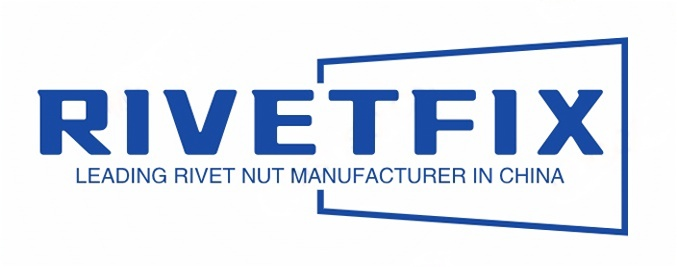
As a leading fastener manufacturer in China with more than 15 years in the industry, Rivetfix are committed to providing first-class quality fasteners and responsive services to the world.
Rivetfix offers a wide range of rivet nuts and rivet nut tools designed to meet the unique demands of your projects. Rivetfix ensures you have the right solution for every application. Choose Rivetfix for versatile, cost-effective, and durable fastening solutions tailored to your specific needs. In addition, we can also provide customized rivet nuts service according to your requirements.
Contact us for project advice and the latest rivet nuts and rivet nut tools quote!
Get High Quality Rivet Nuts Quote!
Send Your Rivet Nut Request
For more than 20 years, Rivetfix has helped customers solve many rivet nuts sourcing needs and technical challenges.
Have a question? Contact us and we’ll provide you with the perfect solution.


